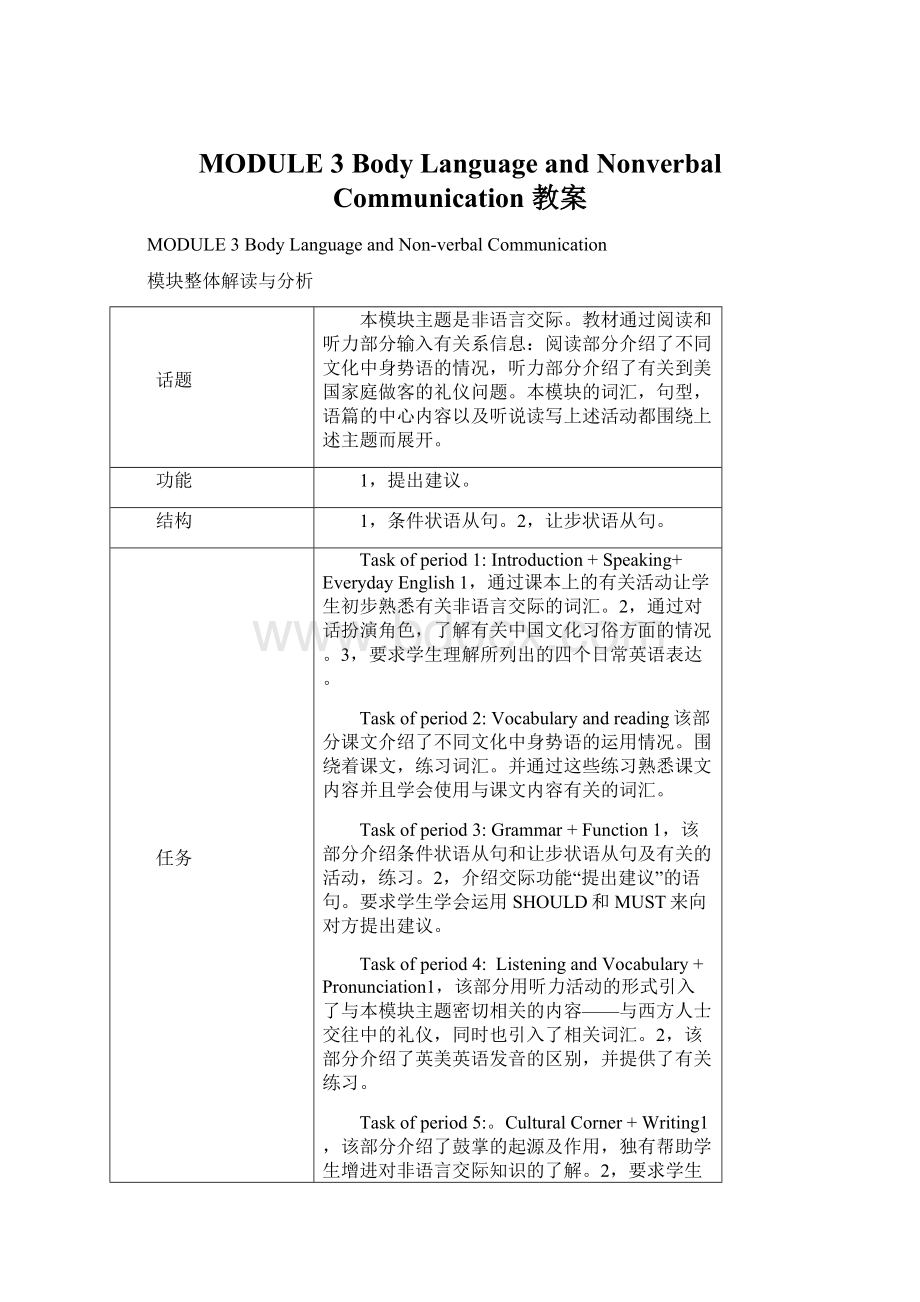MODULE 3 Body Language and Nonverbal Communication教案Word文档下载推荐.docx
《MODULE 3 Body Language and Nonverbal Communication教案Word文档下载推荐.docx》由会员分享,可在线阅读,更多相关《MODULE 3 Body Language and Nonverbal Communication教案Word文档下载推荐.docx(47页珍藏版)》请在冰豆网上搜索。

。
CulturalCorner+Writing1,该部分介绍了鼓掌的起源及作用,独有帮助学生增进对非语言交际知识的了解。
2,要求学生能辨别正式文体与非正式文体的请帖,并能用相应的文体回复。
课时划分
第一课时
Introduction+Speaking+EverydayEnglish
第二课时
ReadingandVocabulary
第三课时
Grammar+Function
第四课时
ListeningandVocabulary+Pronunciation
第五课时
CulturalCorner+Writing
分课时教学设计
一、教学内容分析
教学内容
Module3BodyLanguageandNon-verbalCommunication
教学对象
高一()、()班
教学项目
词语
Communicationcommunicateunconsciousvaryonguardformal
内容
教学目标
语言知识
熟悉有关非语言交际的词汇.日常英语表达.
语言技能
会对话扮演角色,
语言运用
1,通过课本上的有关活动让学生初步熟悉有关非语言交际的词汇。
情感态度
培养学生对生活中语言的丰富产生兴趣。
文化意识
了解中外有关非语言交际的文化习俗。
学习策略
通过相关练习和讨论,正确理解对方话语的含义并作出反应。
教学重点
交际用语以及非语言交际的了解。
教学难点
非语言交际在不同国家的区别。
运用任务
TaskofModule3:
TaskofPeriod1:
了解有关中国文化习俗方面的情况。
熟悉有关非语言交际的词汇。
要求学生理解所列出的四个日常英语表达。
教学方法
任务教学法
教学媒体
交互白板,PPT课件
二、课堂教学过程
预设
时间
教学
步骤
教师活动
学生活动
教学目的
第
1-3
分钟
启动
Greettheclass.
Step1Leadin
Asweknow,wecommunicatewitheachothernotonlybyspokenlanguagebutalsobybodylanguage.Differentbodypositionshavedifferentmeanings.Spokenlanguagesincludesmile,angry,waveandsoon.
问候老师;
观看图片。
引起学生注意力和兴趣。
4-20
词汇学习
Nowmatchtheverbsintheboxwiththepicture.pointshakesmilewave
Thekey:
Atthesametime,theteachershowssomepictures.
a)pointb)wavec)smiled)shake
Andtheteachershowssomeotherbodylanguages.“hangone’shead,pullalongface,embrace,applause,shrugone’sshoulder,frown”
Point:
pointto和pointat都含有“指着”的意思,两者一般可以相互换用.例如:
Theteacherispointingat(to)themaponthewall.老师指着墙上的地图.
但主语是事物时,一般用pointto作谓语.pointat可以分开使用,即point后直接跟名词或代词作宾语,再跟介词at表示方向,意为“把……指向”,而pointto却不得分开使用。
例如:
Thesoldierpointedhisgunatthedoctor.士兵用枪指着医生。
pointout意为“指出”,其中out是副词。
如果它后面的宾语是代词,则必须把该宾语放在out之前。
LuckilythemanknewMrGreenandpointedhimouttous.幸好这个人认识格林先生,于是便把他指给我们看。
pointout后面还可以接宾语从句Step2Listenandmatchthesituationswiththepictures.Theteacherplaysthetape.
3Finishactivity3Theteachermaydividethewholeclassintoseveralgroups.Eachgroupfinishestheirfixedtask.Atlast,eachgroupmayappointtwostudentstoactthesituation.
4
Finishactivity4(freechoices)
Readandanswerthequestions.
听并跟读单词,理解词汇意思。
认知并熟悉新词汇的含义,培养独立学习的能力。
21-26
新词汇学习
ReadoutthefollowingwordsandmakesurethattheSsunderstandthemeaningofeachword.:
aggressive.dealgesturegreetformalinformalpositiontrustunconsciousweapon
跟读单词,理解其词义。
为下一步阅读扫清词汇障碍。
27-38
口语训练
Speaking(page27)
1.Pairwork
两两结对展开对话。
训练学生的交际能力,检查对本模块话题的掌握情况。
39-44
练习
Task2:
EverydayEnglish(page28)Decidewhatthephrases.
选择答案
学习几个日常用语的用法。
45分钟
布置作业
1.AskSstopracticemakingadialogue.2.AskSstopreviewReadingandVocabularyinthemodule.
记录任务。
拓展学习资料。
Module3BodyLanguageandNon-verbalCommunicationReadingandVocabulary
aggressive.dealgesturegreetformalinformalpositiontrustunconsciousweapon
Althoughtheseareveryimportant,wecommunicatewithmorethanjustspokenandwrittenwords.2.Likeotheranimals,weareonguarduntilweknowitissafetorelax.Ifourrighthandisbusygreetingsomeone,itcannotbeholdingaweapon.Nowadays,itisquiteacommongreeting
其它
课文
词汇:
Reading:
通过阅读上下文能够猜测出某些词汇的含义;
Listening:
能听懂有关话题描述;
Speaking:
能运用相关句式描述话题;
Writing:
根据要求,完成有关的句子描述。
根据上下文,学习理解。
培养关注不同的交际意识。
培养关注了解中外有关非语言交际的文化习俗意识。
整体阅读中认知,根据上下文猜测理解某些词汇的含义。
培养阅读上下文猜测词义的技巧。
学习提取文章有用信息,猜测词义的方法。
开发学生想象力,进一步熟练使用本模块词汇。
1-5
Step1presentation
Theteachershowsthreepicturesaboutbodylanguage.OneisthepictureofYangLiping.HerpictureofQueZhiLing(雀之灵);
TheothertwoareaboutMr.Bean,andChaplin.Atthesametime,theteachersays:
Wecangettheinformationfromthebodygesturesbesideslearnedlanguage.SotheteacherpresentsthetitleofthetextBodyLanguage
问候老师。
观看图片,讨论并记录讨论结果。
引入阅读话题,激发学生想象力。
5-6
阅读前
Readthepassageagainandchoosethebesttitle.
1.Sayingitwithoutwords.
2.WheninRome,DoastheRomansDo
3.GreetingsAroundtheworld.
4.ReadMyMind.
完成词汇练习
了解阅读任务。
明确阅读任务。
7-31
阅读中任务
While-reading
Accordingtothetextfillinblanks.
Weusebothandtoexpressourthoughtsandopinionsandto_________withotherpeople.Justlikespokenlanguage,bodylanguagefromculturetoculture.(Thekey:
words;
bodylanguage;
communicate;
varies.)
Everyculturehasdevelopedaformalwaytostrangers.Traditionally,EuropeansandAmericans.Theydothiswiththe
_______hand.ThatmeansItrustyou.I’mnotcarryinga__________weapon.(Thekey:
greet;
shakehands;
right;
threatening)
Greetingsincountriesdonot__touchingtheotherperson,buttheyalwaysinvolvethehands.(Thekey:
Asian;
involve)
TodayAmericanyouthsoftengreeteachotherwiththeexpression,”Bodylanguageisfascinatingforanyonetostudy.Peopleamuchmorebytheirthanbytheirwords.(Thekey:
givemefive;
giveaway;
gestures)
阅读文章,逐一完成各项活动所要求的任务。
核对答案。
通过不同的任务帮助学生在阅读中养成猜测词汇含义的习惯,训练词汇学习的技巧和能力。
32-44
阅读后
Post-reading
2.Individualwork
完成(Page23)的课文练习。
浏览语言点。
听录音。
写出至少五个句子归纳文章大意。
帮助学生更好地理解文中。
通过听录音,巩固词汇及课文理解。
利用书写的形式,训练学生归纳文章主题大意的能力。
45
Readthepassageagainafterclass.
AskSstopreparefortheListeningclass.
记录课后作业。
巩固课文理解;
预习下一个课时
Module3BodyLanguageandNon-verbalCommunicationGrammar+Function
Grammar1,2
掌握条件状语从句,让步状语从句语法
掌握掌握条件状语从句,让步状语从句语法
正确运用。
写出含有条件状语从句,让步状语从句的句子。
增强英语语法学习的信心,正确理解英语语法的作用。
理解英语与汉语在表达形式上的差异。
通过大量的练习,增强对条件状语从句,让步状语从句的理解。
怎样能掌握条件状语从句,让步状语从句。
1.掌握掌握条件状语从句,让步状语从句的灵活运用。
2,提建议。
TaskofPeriod3:
Completetheexercisesabout条件状语从句,让步状语从句的结构练习。
第1
启动教学。
2-25
语法学习
条件状语从句
Lookatthesesentencesfromthepassage.
Ifyousaytheword“communication”,mostpeoplethinkofwordsandsentences.
Weuse“learned”bodylanguagewhenweareintroducedtostrangers.
Nowtickthetruestatements.
Thesentencesfromthepassage.
1.Describecommonsituations.
2.Describeimpossiblesituation.
3.Useiforwhentointroducethesituation.
4.Explaintheresultofthesituationintheotherpartofthesentence.
5.Usethepresentsimpletenseinbothpartsofthesentence.
1,3,4,5我们知道,引导条件状语从句最常用的连词是if,由if引导的条件状语从句表示在某种条件下某事很可能发生。
如:
Ifyouaskhim,hewillhelpyou.如果你请他帮忙,他会帮你的。
Ifyoufailintheexam,youwilllethimdown.如果你考试不及格,你会让他失望的。
另外,if从句还表示不可实现的条件或根本不可能存在的条件,也就是一种虚拟的条件或假设,从句多用一般过去时或过去完成时。
IfIwereyou,Iwouldinvitehimtotheparty.如果我是你,我会邀请他参加聚会。
IwouldhavearrivedmuchearlierifIhadnotbeencaughtinthetraffic.
如果没有堵车,我会到的早一点儿。
那么,除了if之外,是否还有其他连词也可以引导条件状语从句呢?
回答是肯定的,不仅有,还有很多。
这些词由于出现的频率较小,且用法较复杂一些,所以不如if为大家所熟知罢了。
下面就这些词的用法以例句的形式进行一下简单总结。
1.unlessconj.除非,若不,除非在……的时候
Youwillfailtoarrivethereintimeunlessyoustartearlier.如果你不早点动身,你就不能及时赶到那儿。
Unlessitrains,thegamewillbeplayed.除非下雨,比赛将照常进行。
2.oncondition(that)...在……条件下,如果
oncondition(that)...引导的条件从句是主句事件发生的前提条件或唯一条件。
Icantellyouthetruthonconditionthatyoupromisetokeepasecret.
我可以告诉你真相,条件是你答应保守秘密。
Youcangoswimmingoncondition(that)youdon'
tgotoofarfromtheriverbank.
你只有在不远离河岸的条件下才可以下水游泳。
3.supposingconj.如果,假如
supposing引导的条件从句表示一种假设条件。
Supposingitrains,shallwecontinuethesportsmeeting?
倘若下雨,我们的运动会还要继续举行吗?
Supposingsomethingshouldgowrong,whatwouldyoudothen?
假如出了什么问题,你准备怎么对付?
4.providedconj.假如,除非,以……为条件
provided(that)+从句表示一种假设条件。
Hewillsignthecontractprovidedweoffermorefavorableterms.
如果我们提出更优惠的条件,他就会在合同上签字。
Hewon'
tbeagainstusinthemeetingprovidedthatweaskforhisadviceinadvance.如果我们提前征求一下他的意见,他就不会在会上反对我们。
另外还有incase,as/solongas
Incaseitrains,donotexpectme.如若下雨,就不要等我了。
Aslongasyoupromisetocome,I’llwaitforyouuntilyoucome.
只要你答应,我就等你来。
从上述例句可以看出if,unless,oncondition(that),supposing,provided等词引导的条件状语从句,主从句条件关系分明,结构清晰。
在条件状语从句中,用一般现在时代替一般将来时,一般过去时代替过去将来时。
但有些句子,虽没有含条件关系的连词,却也隐含着条件关系,这些句子常用一些词,如butfor,without等引出一个介词结构来表示条件,条件常常是虚拟的,或与事实相反的假设。
butfor若非,要不是
Butfortherain,weshouldhaveapleasantjourney.
要不是下雨,我们的旅行肯定会很愉快。
Butforyourhelp,weshouldnothavefinishedintime.
要不是你帮忙,我们肯定不能及时完成任务。
Step3
Findmoreexamplesofsentenceswithiforwheninthepassage.
1)Ifourrighthandisbusygreetingsomeon